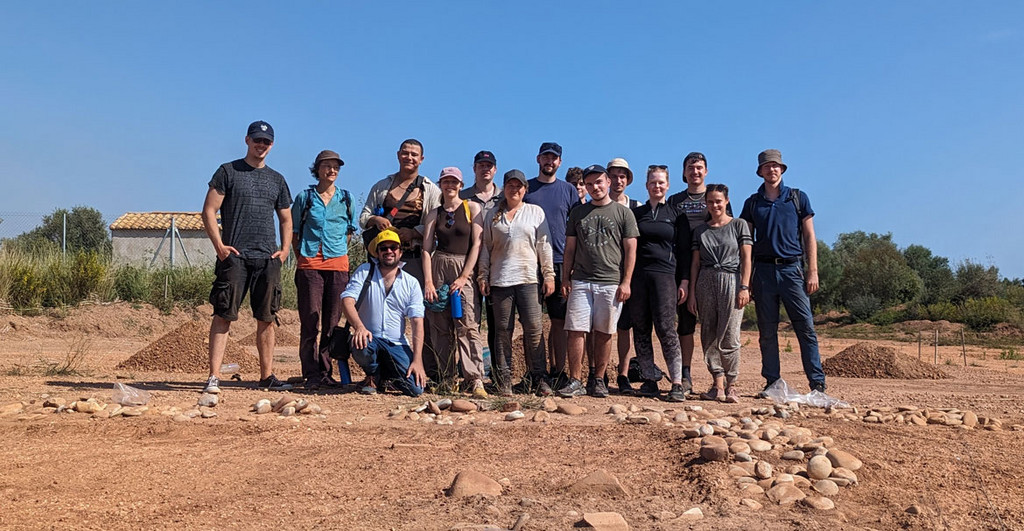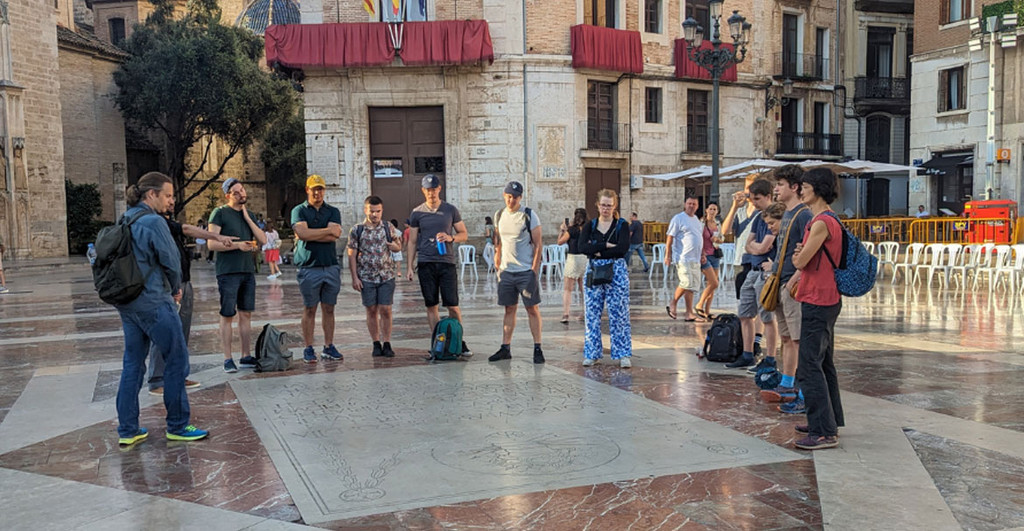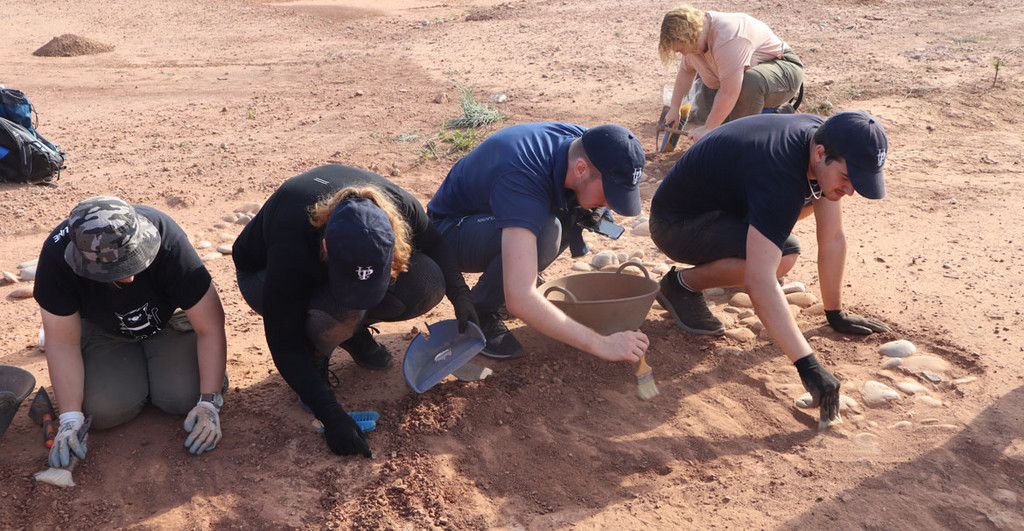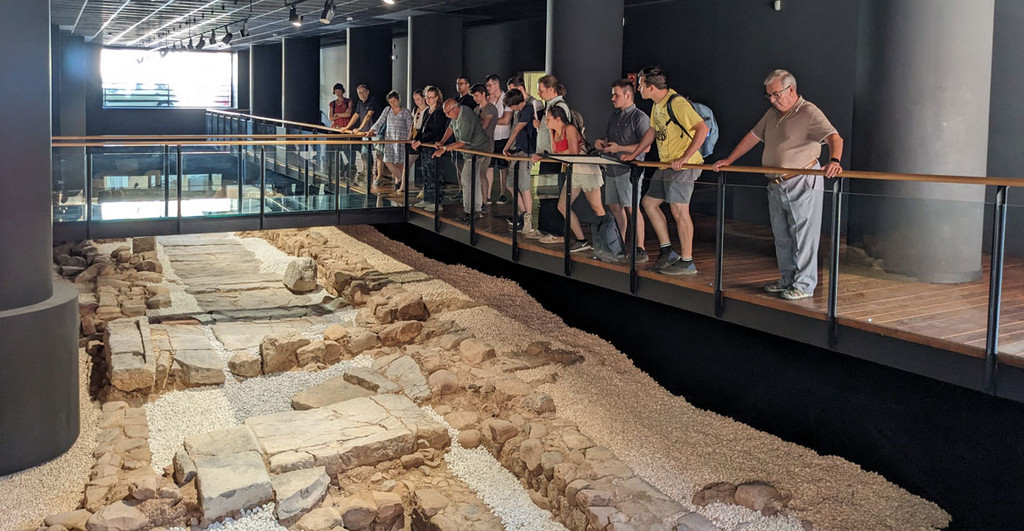Students studying history or classical philology at the University of Potsdam usually learn about archaeological excavations from books, films, or presentations. Filippo Carlà-Uhink wanted to change that. The Professor of Ancient History organized an exchange with Spain's Jaume I University as part of the EDUC university alliance, which took a group of students to Castellón de la Plana in October 2023 – and straight to an excavation site where they eagerly got their hands dirty. Matthias Zimmermann spoke to Carlà-Uhink, his colleague Dr. Eike Faber, and student Luca Alacán Friedrich, who traveled to Spain with them – about the trip, important experiences, and what makes EDUC so special.

In October, a group of students from Potsdam traveled to Spain on an excursion you led. What was the reason for and purpose of the trip?
Prof. Dr. Filippo Carlà-Uhink: The trip was part of an exchange program within the EDUC university alliance, in which seven universities from six countries are networked alongside the University of Potsdam, including the University Jaume I in Castellón de la Plana, Spain. Our students were able to go on some very exciting day trips there – to Sagunto and Valencia – but above all they took part in an international archaeological training excavation in Burriana. For students who had never been to an archaeological excavation before, this was an enormously important experience.
Luca Alacán Friedrich: The excavations were a real highlight! Hands-on history, so to speak. We were guided and supported by professionals from the local archaeological museum and were able to advance a real archaeological excavation – even though we were non-professionals.
Carlà-Uhink: The site where the training excavation was supposed to take place, a villa maritima that archaeologists have been working on since 2008, was inaccessible due to persistent rainfall. But thanks to the dedication of the Burriana Archaeological Museum and the regional archaeology department, the group was able to switch to another excavation site. Necropolises, a road, and a building were found during road construction work, and the students were able to help uncover them.

Can you take us on a virtual recap of the trip?
Dr. Eike Faber: The trip lasted from October 1 to 7, including four days of work on the excavation site and in the museum. We spent half our day in the heat, on all fours and with mosquitoes buzzing all around. This practical experience shock was immense – and important. To realize how quickly a layperson can break something, to learn how not to do it and instead recover something that the archaeologists can then work with. Then to process and classify what was found in the archaeological laboratory. During the four days, the students did almost everything that archaeologists do in the course of a whole year.
Alacán Friedrich: It was great to experience all the steps of archaeological work! Initially, everyone was assigned to a marked-out field, perhaps five square meters, and given instructions on how to proceed: clearing away rubble, carefully uncovering possible finds ... The joy when you find a piece of urn, a bone, or a tooth. Artifacts that already seem worthy of museums to us, but on which so much work is still being done. This brings you very close to history!
Faber: The second part is extremely important! It was great to see how it just clicked with the students. You can tell them about it for weeks, but when they remove the dirt themselves with the spatula and then create the documentation so that others can continue working with it – this practice is so important. No checklist can replace this.
Carlà-Uhink: For example, the students worked with cinerary urns containing the remains of human bodies that died several thousand years ago. Digging them up with your own hands and developing an awareness for this... It is extremely important for historians to see such sources with their own eyes. The University of Potsdam does not have an archaeology department and yet our students can gain such experience thanks to the cooperation!
Alacán Friedrich: I am studying chemistry and history to become a teacher and I am sure that this experience will really help me on my journey. It is a shame that this is not available to everyone.
Carlà-Uhink: I think this will actually help future history teachers a lot. And I don't just mean because they know how archaeology works, but also with regard to very specific and even regional aspects. For example, history teachers could discover buried cultural monuments in the state of Brandenburg as places of learning and present them to their pupils.
Dr. Eike Faber: Last but not least, the training excavation was a truly international event: In addition to Spanish and German students, there were also French and Italian students.
Alacán Friedrich: We had many opportunities for exchange and networking. Because we were so close together for such a long time throughout the day, it was in some ways much more intense than longer stays abroad can be, where you study alone, at best together with the other "internationals", at an otherwise foreign university. And who knows: Perhaps some students will already have an idea of where to go for an Erasmus semester as a result of the conversations.

Travel diary – where and how?
Alacán Friedrich: We thought it made sense to document this – for ourselves, but also for others who are interested. I think it has become a beautiful and visual diary. And it has shown us that quite a few people have contributed to making this excursion possible.
In November, Spanish students paid a visit to Potsdam in return ...
Faber: Exactly. The program is designed as an exchange. A few weeks after our trip to Castellón, a group from Jaume I University came to Potsdam. For our students, it was part 2 of the trip so to speak, only this time they were the hosts and had to organize the agenda. On the one hand, we had our teaching and research, and on the other hand there was the Berlin-Brandenburg research landscape, which is very extensive. We had excursions to Brandenburg to the Archaeological State Museum and to Berlin, for example to the Berlin-Brandenburg Academy of Sciences and Humanities, but also directly "on our doorstep" to Sanssouci Park, where we were able to present key aspects of ancient history at the University of Potsdam using the example of statues with antique motifs and explain aspects of the history of reception.
Alacán Friedrich: We, the students, prepared and led the tours ourselves. This was also informative for us and another important experience. We also showed our Spanish guests the Christmas market – including the first snow. Many of them were mesmerized by it!

The exchange program is funded by EDUC. How does it fit into the alliance’s work?
Carlà-Uhink: We have been involved in EDUC from the very beginning, working closely with partners in Pécs (Hungary) and Cagliari (Italy). For example, we had already organized excursions to Italy. It was an absolute stroke of luck for us when Jaume I University joined EDUC in 2022: My predecessor as Professor of Ancient History, Prof. Dr. Dr. h. c. Pedro Barceló, came to Germany from the region a long time ago and fostered relations with his home region and the institutions there, including the university, over the years – we were able to build on this. EDUC is based on the idea of promoting student mobility within Europe. It enables tailor-made forms of mobility, sometimes shorter, sometimes digital, and hopefully we will see a whole jointly organized degree program in the future.
Moreover, thanks to EDUC, a program like ours is not a one-off – and therefore has a lasting effect. The students see each other again and form long-term bonds. And perhaps they will then decide to spend a period abroad (e.g. via Erasmus+) at our partner university in Spain, or to write a thesis with a second examiner from among the colleagues at Jaume I University. I think the exchange program is important and I am very happy that I was able to take part in it as a lecturer. The flexibility and the variety of networking options that EDUC offers are great – in 2025, for example, we are also organizing a "Blended Intensive Program" with the universities of Cagliari and Paris Nanterre.
So the exchange will take place again in 2024. How is the organization going and who can participate this year?
Carlà-Uhink: From 2024, we will help organize the event, hopefully for a few years. We now want to participate regularly with students from Potsdam – and I will also be involved as a lecturer. Five students from Potsdam will travel to Spain in October. Students of all subjects could take part, but ultimately it will probably be mainly those whose program has a connection to history and excavations from Roman times. The agenda will be similar to 2023: There will be excursions to museums, historical sites – and of course, a week at the excavation site. We are already looking forward to it!
The travel diary for the Summer School in Burriana 2023: https://www.uni-potsdam.de/de/hi-altertum/summer-schools/summer-school-2023
Information about the program: https://www.uni-potsdam.de/de/hi-altertum/summer-schools
Article by Matthias Zimmermann (University of Potsdam)